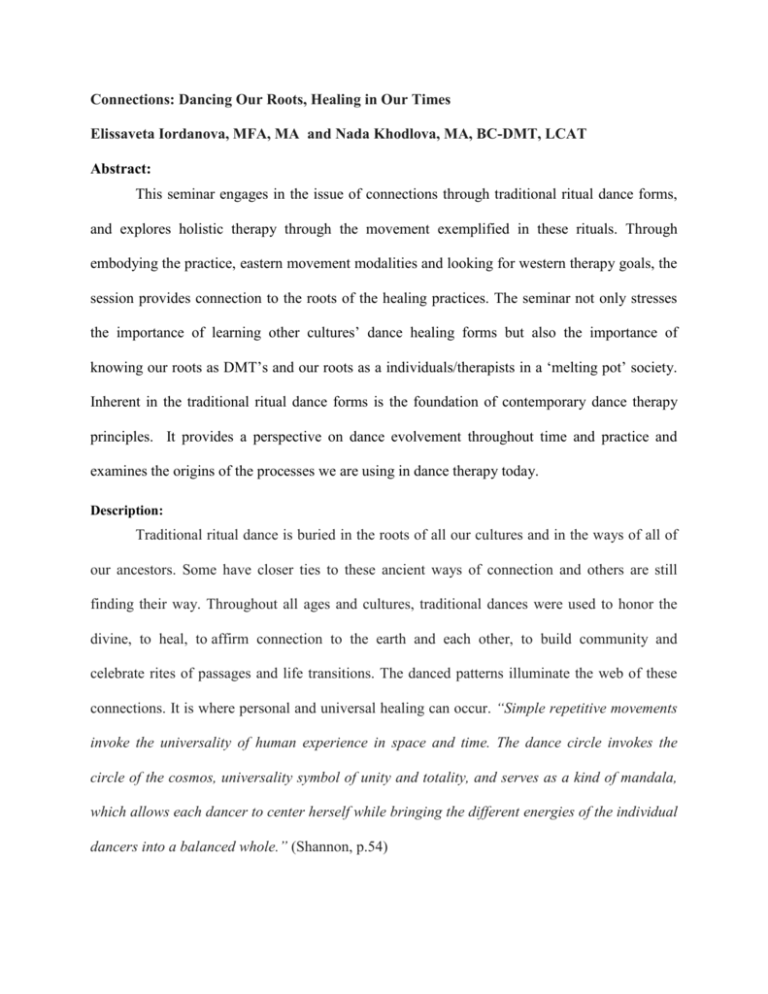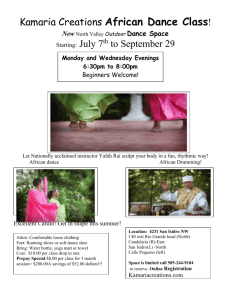Connections: Dancing Our Roots, Healing in Our
advertisement

Connections: Dancing Our Roots, Healing in Our Times Elissaveta Iordanova, MFA, MA and Nada Khodlova, MA, BC-DMT, LCAT Abstract: This seminar engages in the issue of connections through traditional ritual dance forms, and explores holistic therapy through the movement exemplified in these rituals. Through embodying the practice, eastern movement modalities and looking for western therapy goals, the session provides connection to the roots of the healing practices. The seminar not only stresses the importance of learning other cultures’ dance healing forms but also the importance of knowing our roots as DMT’s and our roots as a individuals/therapists in a ‘melting pot’ society. Inherent in the traditional ritual dance forms is the foundation of contemporary dance therapy principles. It provides a perspective on dance evolvement throughout time and practice and examines the origins of the processes we are using in dance therapy today. Description: Traditional ritual dance is buried in the roots of all our cultures and in the ways of all of our ancestors. Some have closer ties to these ancient ways of connection and others are still finding their way. Throughout all ages and cultures, traditional dances were used to honor the divine, to heal, to affirm connection to the earth and each other, to build community and celebrate rites of passages and life transitions. The danced patterns illuminate the web of these connections. It is where personal and universal healing can occur. “Simple repetitive movements invoke the universality of human experience in space and time. The dance circle invokes the circle of the cosmos, universality symbol of unity and totality, and serves as a kind of mandala, which allows each dancer to center herself while bringing the different energies of the individual dancers into a balanced whole.” (Shannon, p.54) The dance experience we share invites us to dig, unearth and relish in these roots and allows them to feed, nourish and ground us in a way that our ancestors knew and some indigenous peoples and non western cultures still know today. The dances provide a source of knowing, wisdom, and connection inviting us into them as sacred nonverbal text that reweaves all the threads of connection providing us with the full colors of the fabric of life. For example “The Bulgarian ritual dance, as we know it today, is usually a simple formula repeated over and over again. This repetition takes the performers beyond the reality of everyday life through movement and mental atonement. It is a special state of being, a sojourn into the sacral world. That essential knowledge which is not normally realized which cannot be explained, is activated and experienced during the dance ... the ritual dance is action which has an influence on nature, on the creation of order in society and on relations between people: it is arrangement, harmonization, atonement, and communication with the sacral world; it is purification, magic and initiation.”(Ilieva/Shtarbanova, p. 2-3) Traditional ritual dance is buried in the roots of Dance/Movement therapy as well. The 12th International Panel at the ADTA’s conference investigated the impact of traditional dance forms on dance/movement therapy training and practice. DMT elements and concepts are inherently embedded in the traditional ritual dance experience. It is suggested that making traditional ritual dance a regular practice in our personal lives and emphasizing its proper place in DMT study and practice can have profound effects not only in healing ourselves, our communities, and our current society but is that it is necessary and essential. Leventhal confirms, “Actually, dance in its therapeutic and healing capacities, is one of the oldest forms of healing interventions and experiences know to humankind century upon century, in ancient and preindustrial cultures. The powers of ritualistic movement, trance excitation, and community exultation and release were forms generated and integrated into a culture’s social organizations:”(p. 9) Adler goes further and speaks to the sense of being born into a belonging, embodiment of the collective, a sense of tribe, that our current western society is excruciatingly suffering a lack of today. “Within the last century, change away from tribal living has accelerated dramatically. For countless centuries preceding this change, we belonged before we asked “who am I?” We were born belonging, not only to a tribal body but we belonged to the earth-body. We were held by a sacred vessel. As the Western world has developed, we have increasingly been urged first toward the question: “Who am I?” forgetting about the essential relationship between the individual and the interconnectedness among all beings, encouraged to leave the sacred circle.” (p.82) The traditional dance experience connects us to spirit. The body serves as a conduit for transcendence, the hypnotic repeated body chanting dance steps casting each dancer into a state beyond themselves. As Wosien states, “in this way the body, in the whole range of its experience, is the instrument for the transcendent power; and this power is encountered in the dance directly instantly and without intermediaries” (p. 9) and further, “in dance ritual-and all early ritual is dance-man undertook to represent his god, celebrating and commemorating the god’s measured movements in creation and the traces of his journey on earth.” (Wosien, p.13) The traditional dance experience connects us to the earth body and the web of life. As we align ourselves with the universal energy of healing in the dances we are transcending the limitations of our ‘selves’ and reconnecting with the web. Many of the dances have their roots in the earliest civilizations in Europe and the near east, back when European indigenous culture, in common with other indigenous cultures on the planet, embodied a healthy world view which honored the earth, the body and the feminine. The traditional dance experience us connects us to each other as we sense shared rhythms and efforts. To be in synchrony with others in the dances creates an atmosphere of mutual holding and support. This can provide an essential safe container for the deeper work that the work induces. The simple repetitive movements in a ‘body chanting’ form evoke the universality of human experience in space and time. As dancers weaving these ancient patterns into the present we are unconsciously synchronizing body rhythms and brain waves, creating a healing container on a cellular level. The traditional ritual dance experience connects us deeper home into ourselves. The dances containing some of the oldest dance patterns have symbolic encoded meanings. The structure of the dance, including the steps, handhold, tempo, formation carries meaning. There are subtleties of style and technique such as whether the steps are large or small, hard or soft, quick or slow; where the movement initiates in the body, what chakras are activated, what plane the dance emphasizes, as well as every other detail of carriage and posture. The possibilities are endless. All require us to look deep within. Much can be revealed about not only the symbolism and story of the dance but also what our own preferences are. Examining our own preferences, patterns, movement preferences/styles, and tension holding patterns can give us a map to our inner psyche and how we dance in the world. Khodlova writes, that self pleasure is paramount as the inner earth is reveled in “its roots and soil like a worm shifting, loosening, and aerating the soil, the vertical shaking is at once a rising of energy and a gathering up and harvesting, as well as, a release and shedding of what is old and dying and no longer needed. Reawakening, reliving.... the ancient bodies” As we attentively dance and plug into the wisdom, healing and transformative nature of the dances we reweave ourselves into the time honored web of life. “Dance therapy is both a modern and an ancient art of healing.”( Serlin. p.65). May we all reweave into the cosmos experience of self and the web of all life through dancing together, holding hands, in synchrony, in union with all that is and ever was. References 1. Adler, J. (1996). The Collective Body. American Journal of Dance Therapy #18.( pp.81-94). 2. Capello, P. (2007) Dance as our Source. American Journal of Dance Therapy, #29.(pp.37-50). 3. Ilieva, A. and Shtarbanova, A. (2005) “Zoomorphic Images in Bulgarian Women’s Ritual Dances in the Context of Old European Symbolism”. The Journal of Archaeomythology. #1. (pp.2-11). 4. Khodlova, N. (2009) Exile and Homecoming: Women’s Ritual Dance Training. 5. Leventhal, M. (2008) Transformation and Healing Through Dance Therapy: The Challenge and Imperative of Holding the Vision, American Dance Therapy Journal, #30 (pp.4-23) 6. Shannon, L. (1992) Living Ritual Dance for Women: Journey out of Ancient Times. American Dance Therapy Association 27th Annual Proceedings (pp. 200-203). 7. Serlin, I. (1993) Root Images of Healing in Dance Therapy. American Journal of Dance Therapy, #15, (pp.)65-76. 8. Wosien, M. (1974). Sacred dance: Encounter with the gods. NY: Avon Books.





